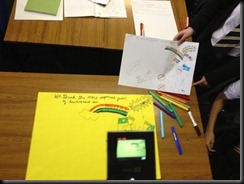This is a ‘how to’ post that was inspired by this post over at Noel Jenkins’ excellent Digital Geography. This in turn led me to another useful and creative blog by Paul Blogush and this post on creating RSA Style animation videos with the class. If you want to know how to do it properly, I recommend that you head over to Noel and Paul’s posts first.
This post is the story of how a class of Year 10 Geography students got on with the challenge. Before I start, It’s worth looking at how the experts do it:
During the development unit, I wanted time to really explore the idea of the factors that affect the economic development of countries. In particular, I’ve always struggled to get students to link these factors together. After some of the more traditional lessons, I decided to give this a try. In the end, it took 3 ‘double lessons’ so 6 hours in total.
A simple PowerPoint is embedded below that helped to guide the process.
The first two hours were spent setting up the story. I used Paul’s idea of ‘steps’ and asked students to create and introduction; then focus on three factors before attempting a conclusion. I let the class decide upon their own groupings, but between three and four students worked well. Once the plan was put together, the class then used A3 paper to practise their drawings. The main thing is that they had to capture the animation in one, long take.
The next two hours were spent setting up. We have access to six flip cameras; six tripods and around four MacBooks with iMovie.


The images above show the basic set up. The camera was allowed to run and the typical ‘take’ took between 12 and 25 minutes depending on the complexity of the graphics. The practise drawings were very useful in guiding the class. This was very messy in terms of time and ‘off-task’ time, but a natural evaluation and feedback loop started with students critically evaluating their own and others’ work. The main loss here was the ‘moving camera’ style of the original RSA animations. However, having the cameras attached to tripods and ‘static’ really improved the presentation style. Before filming, I allowed the class to take a look at my own attempts:
I would really recommend going through the process as a teacher before letting a whole class loose!
The final two hours were spent narrating, sharing and reviewing the videos.
We used MacBooks and iMovie as the combination allows easy manipulation of audio and the narration tool rocks. The process was:
Here they are in all of their glory. The class would welcome your comments:
This post is the story of how a class of Year 10 Geography students got on with the challenge. Before I start, It’s worth looking at how the experts do it:
During the development unit, I wanted time to really explore the idea of the factors that affect the economic development of countries. In particular, I’ve always struggled to get students to link these factors together. After some of the more traditional lessons, I decided to give this a try. In the end, it took 3 ‘double lessons’ so 6 hours in total.
A simple PowerPoint is embedded below that helped to guide the process.
The first two hours were spent setting up the story. I used Paul’s idea of ‘steps’ and asked students to create and introduction; then focus on three factors before attempting a conclusion. I let the class decide upon their own groupings, but between three and four students worked well. Once the plan was put together, the class then used A3 paper to practise their drawings. The main thing is that they had to capture the animation in one, long take.
The next two hours were spent setting up. We have access to six flip cameras; six tripods and around four MacBooks with iMovie.


The images above show the basic set up. The camera was allowed to run and the typical ‘take’ took between 12 and 25 minutes depending on the complexity of the graphics. The practise drawings were very useful in guiding the class. This was very messy in terms of time and ‘off-task’ time, but a natural evaluation and feedback loop started with students critically evaluating their own and others’ work. The main loss here was the ‘moving camera’ style of the original RSA animations. However, having the cameras attached to tripods and ‘static’ really improved the presentation style. Before filming, I allowed the class to take a look at my own attempts:
I would really recommend going through the process as a teacher before letting a whole class loose!
We used MacBooks and iMovie as the combination allows easy manipulation of audio and the narration tool rocks. The process was:
- Get the video onto the Mac and imported into iMovie. This is an automatic process if iMovie is open.
- Remove the original track audio. This is a great feature as it allowed the classroom to be quite noisy during filing, necessary for instructions to be given.
- Speed up the video to produce a 2 minute video. This is where using a tripod really pays dividends!
- Allow the students to review the script written.
- Using the narration tool, record the audio in one hit. This is where I’d do things differently next time as the background noise for some of the videos is distracting.
Here they are in all of their glory. The class would welcome your comments:







Comments
Post a Comment